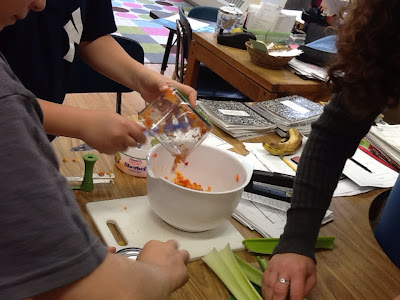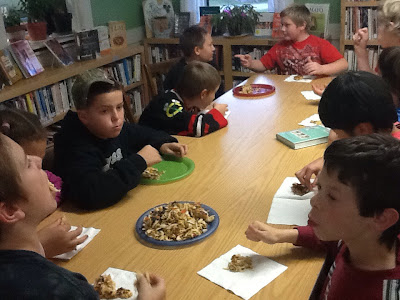What did I expect? I was trying a recipe for the very first time and had no idea whether the recipe would work well, so it was already like rolling the dice...
The recipe was for a cheese that doesn't require any culture or rennet. Instead, vinegar is used to separate the curds from the whey. (Making cheese always makes me want to recite Little Miss Muffet...) I found the recipe at this website, also a great resource for cheesemaking ingredients and materials.
The plan was that in the afternoon as math was ending, I'd start warming up a gallon of milk with a few teaspoons of salt sprinkled in. While it heated to the boiling point, kids would read an amalgamation of two online articles I cut, pasted and printed out on one page about the food traditions of the Midwestern states. They would read to find out:
- what foods are grown/harvested/produced in the Midwest
- what the cultural backgrounds of many of the immigrants to that region are
- what food traditions they brought with them from countries including Germany and the Scandanavian nations.
By the time everyone had read the article, the milk would be warm enough to remove from the heat. We'd pour a cup of vinegar into the heated milk, see the whey separate from the curds, then leave it to sit while we discussed the article. Before the majority of the class left for Chorus, we'd put the curds in cheesecloth and leave it to drain. I'd refrigerate it overnight and we'd eat cheese and crackers at snack on Tuesday.
That was the plan.
Unfortunately it took over an hour for the milk to warm up to 190 degrees.
Should I have taken it out of the fridge at lunch and brought it to room temperature? Yes.
Should I have put it on the stove and started warming it up sooner? Yes.
Could I have anticipated how ridiculously slow the stove is to heat up? Maybe, but I didn't.
We finished the article, and the milk was barely tepid. Did I mention that my building principal had stopped in and was visiting the class and reading the article with kids? (Disclaimer: he does not do Gotcha! evaluations. But when he has some time, he will stop in and to visit classrooms and interact with students. It's in no way evaluative, but understandably, you kind of want things to go smoothly when he stops by.)
Time to improvise: I gathered the class in the meeting area and we went over the worksheet together. I told them we were making cheese in recognition of the large amounts of cheese made in Wisconsin. Luckily I had also brought in some wheat berries so we talked about what they were and passed a small amount of them around for everyone to look at up close. Later in the week we may boil some up and eat them with butter, just to appreciate the grain in its unmilled form.
By now the milk was about 140 degrees. More than half the class packed up for the day and went to Chorus. I promised to have the rest of the class help me finish off the cheese and take pictures to share on Tuesday.
The good news is that the kids that remained are some of the ones who are most excited about cooking projects week after week. We started a study hall and when the milk (finally) hit 190, we took it off the heat and mixed in the vinegar. Instant curds and whey! We took pictures, let it sit a while, and before they left we put the curds in the cheesecloth and started it draining.


Today we ate it at snack. It didn't taste bad...in fact it had very little flavor at all. But it did have the interesting consistency of play-doh, as one student noted. My guess is the lack of flavor is due to the lack of culture that is usually at work created curds out of the milk solids. Certainly you could add more salt, herbs, or other seasonings as you drain the whey. One of the adults who works in my room copied the recipe and plans to try it. I think this experience will also be useful when we get to kitchen chemistry.
But next time, I'll start the stove sooner.


















